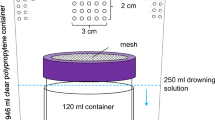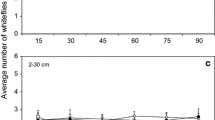Abstract
Volatile chemicals from tryptic soy broth cultures ofStaphylococcus aureus that attract sugar-fed, protein-hungry adult Mexican fruit flies were identified. Chemicals identified from the headspace above the filtrate of the bacterial cultures were ammonia, trimethylamine, isoamylamine, 2-methylbutylamine, 2,5-dimethylpyrazine, and acetic acid. Each chemical attracted flies. A mixture of the chemicals in the same concentrations as were found in the bacterial filtrate was 89% as effective in attracting flies as the bacterial filtrate in laboratory bioassays. Additional chemicals were identified from various concentrated or pH altered preparations made from the filtrate. Many of these chemicals also attracted flies. One of these chemicals, dimethylamine, was the most effective chemical identified. The use of solid-phase microextraction for volatile collection and of thick-film (5-µm) capillary GC columns was essential to the success of this work.
Similar content being viewed by others
References
Bateman, M.A. andMorton, T.C. 1981. The importance of ammonia in proteinaceous attractants for fruit flies (Family: Tephritidae).Aust. J. Agric. Res. 32:883–903.
Belardi, R., andPawliszyn, J. 1989. The application of chemically modified fused silica fibres in the extraction of organics from water matrix samples and their rapid transfer to capillary columns.Water Pollut. Res. Can. 24:179–191.
Boush, G.M., andMatsumura, F. 1967. Insecticidal degradation byPseudomonas melophthora, the bacterial symbiote of the apple maggot.J. Econ. Entomol. 60:918–920.
Drew, R.A.I. 1987. Behavioural strategies of fruit flies of the genusDacus (Diptera: Tephritidae) significant in mating and host-plant relationships.Bull. Entomol. Res. 77:73–81.
Drew, R.A.I., andFay, H.A.C. 1988. Comparison of the roles of ammonia and bacteria in the attraction ofDacus tryoni (Froggatt) (Queensland fruit fly) to proteinaceous suspensions.J. Plant Prot. Tropics 5:127–130.
Drew, R.A.I., andLloyd, A.C. 1989. Bacteria associated with fruit flies and their host plants, pp. 131–140,in A.S. Robinson and G. Hooper (eds.). Fruit Flies, Their Biology, Natural Enemies and Control, Vol. 3A. Elsevier, New York.
Fitt, G.P., andO'Brien, R.W. 1985. Bacteria associated with four species ofDacus (Diptera: Tephritidae) and their role in the nutrition of the larvae.Oecologia 67:447–454.
Gow, P.L. 1954. Proteinaceous bait for the Oriental fruit fly.J. Econ. Entomol. 47:153–160.
Hayward, N.J., Jeavons, T.H., Nicholson, A.J.C., andThornton, A.G. 1977. Methyl mercaptan and dimethyl disulfide production from methionine byProteus species detected by headspace gas-liquid chromatography.J. Clin. Microbiol. 6:187–194.
Heath, R.R., andManukian, A. 1992. Development and evaluation of systems to collect volatile semiochemicals from insects and plants using a charcoal-infused medium for air purification.J. Chem. Ecol. 18:1209–1226.
Hellmuth, H. 1956. Untersuchungen zur Bakteriensymbiose der Trypetiden (Diptera).Z. Morphol. Oekol. Tiere 44:483–517.
Jang, E.B., andNishijima, K.A. 1990. Identification and attractancy of bacteria associated withDacus dorsalis (Diptera: Tephritidae).Environ. Entomol. 19:1726–1731.
MacCollom, G.B., Lauzon, C.R., Weires, R.W., Jr., andRutkowski, A.A. 1992. Attraction of adult apple maggot (Diptera: Tephritidae) to microbial isolates.J. Econ. Entomol. 85:83–87.
MacCollom, G.B., Lauzon, C.R., Payne, E.B., andCurrier, W.W. 1994. Apple maggot (Diptera: Tephritidae) trap enhancement with washed bacterial cells.Environ. Entomol. 23:354–359.
Martinez, A.J., Robacker, D.C., Garcia, J.A., andEsau, K.L. 1994. Laboratory and field olfactory attraction of the Mexican fruit fly (Diptera: Tephritidae) to metabolites of bacterial species.Fla. Entomol. 77:117–126.
Miyazaki, S., Boush, G.M., andBaerwald, R.J. 1968. Amino acid synthesis byPseudomonas melophthora, bacterial symbiote ofRhagoletis pomonella (Diptera).J. Insect Physiol. 14:513–518.
Petri, L. 1910. Untersuchung uber die Darmbakterien der Olivenfliege.Zentralbl. Bakteriol. Parasitenkd. Infektionskr. Hyg. 26:357–367.
Robacker, D.C., andGarcia, J.A. 1993. Effects of age, time of day, feeding history, and gamma irradiation on attraction of Mexican fruit flies (Diptera: Tephritidae), to bacterial odor in laboratory experiments.Environ. Entomol. 22:1367–1374.
Robacker, D.C., andMoreno, D.S. 1995. Protein feeding attenuates attraction of Mexican fruit flies (Diptera: Tephritidae) to volatile bacterial metabolites.Fla. Entomol. 78:62–69.
Robacker, D.C., andWarfield, W.C. 1993. Attraction of both sexes of Mexican fruit fly,Anastrepha ludens, to a mixture of ammonia, methylamine, and putrescine.J. Chem. Ecol. 19:2999–3016.
Robacker, D.C., Garcia, J.A., Martinez, A.J., andKaufman, M.G. 1991. Strain ofStaphylococcus attractive to laboratory strainAnastrepha ludens (Diptera: Tephritidae).Ann. Entomol. Soc. Am. 84:555–559.
Robacker, D.C., Warfield, W.C., andAlbach, R.F. 1993. Partial characterization and HPLC isolation of bacteria-produced attractants for the Mexican fruit fly,Anastrepha ludens.J. Chem. Ecol. 19:543–557.
Stammer, H.J. 1929. Die Bakteriensymbiose der Trypetiden (Diptera).Z. Morphol. Oekol. Tiere 15:481–523.
Zhang, Z., andPawliszyn, J. 1993. Headspace solid phase microextraction.Anal. Chem. 65:1843–1852.
Author information
Authors and Affiliations
Rights and permissions
About this article
Cite this article
Robacker, D.C., Flath, R.A. Attractants fromStaphylococcus aureus cultures for Mexican fruit fly,Anastrepha ludens . J Chem Ecol 21, 1861–1874 (1995). https://doi.org/10.1007/BF02033682
Received:
Accepted:
Issue Date:
DOI: https://doi.org/10.1007/BF02033682




